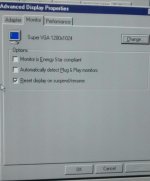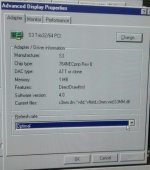Hello!
I'm working on setting up a PC for some DOS gaming and pulled out an old Acer.
I'd like to avoid reinstalling Windows 95 (drivers....) so I was hoping someone could assist me with the video performance of this.
All drivers are installed and I've added a Voodoo 2 card, however the video performance within Windows 95 is incredibly sluggish, having to redraw the screen strip by strip.
Also I've increased the Color palette to 16bit, but it doesn't seem to have taken... everything is still flat and ugly as if it in 256 color mode.
Any ideas/tips?
Thanks!
-Randy
I'm working on setting up a PC for some DOS gaming and pulled out an old Acer.
I'd like to avoid reinstalling Windows 95 (drivers....) so I was hoping someone could assist me with the video performance of this.
All drivers are installed and I've added a Voodoo 2 card, however the video performance within Windows 95 is incredibly sluggish, having to redraw the screen strip by strip.
Also I've increased the Color palette to 16bit, but it doesn't seem to have taken... everything is still flat and ugly as if it in 256 color mode.
Any ideas/tips?
Thanks!
-Randy


